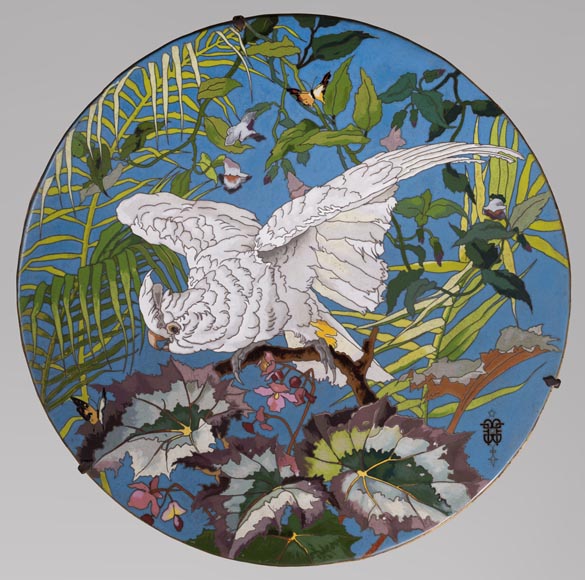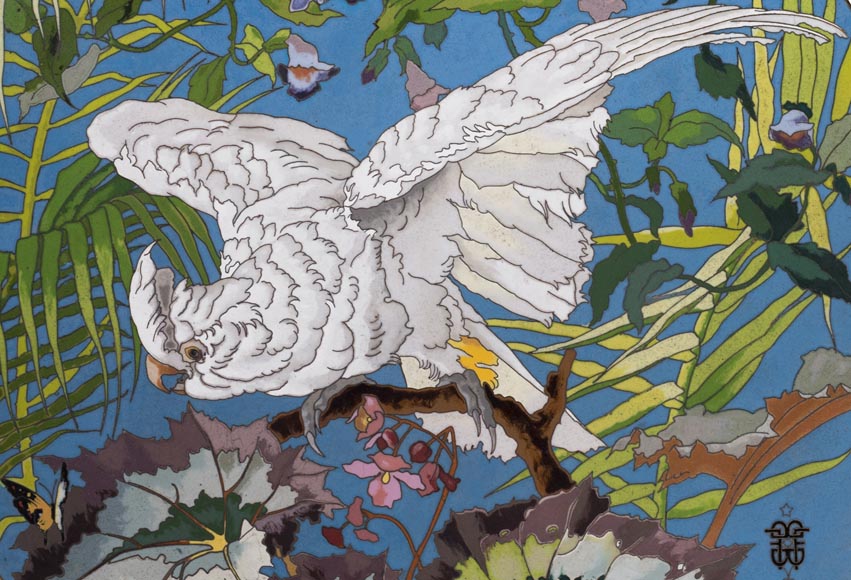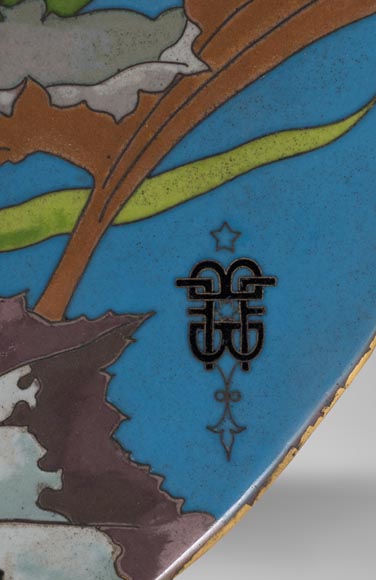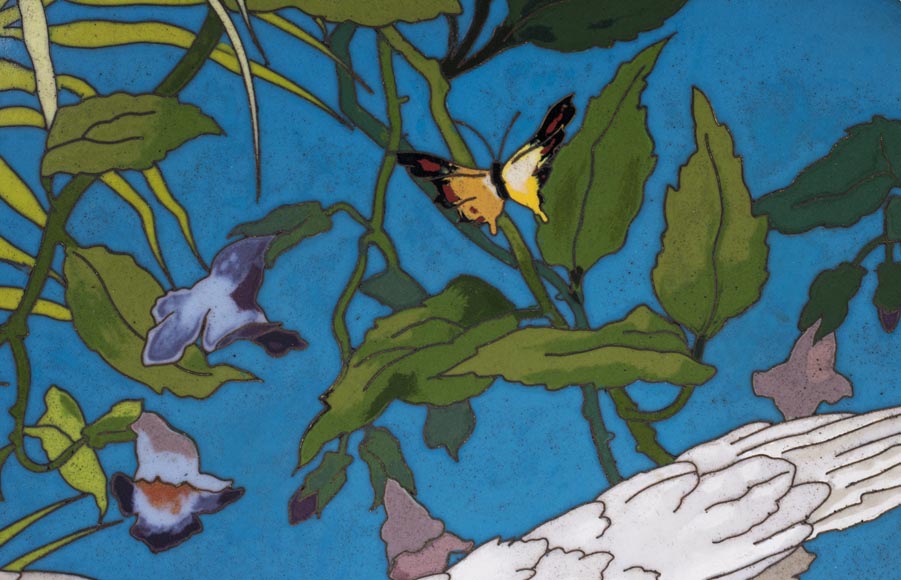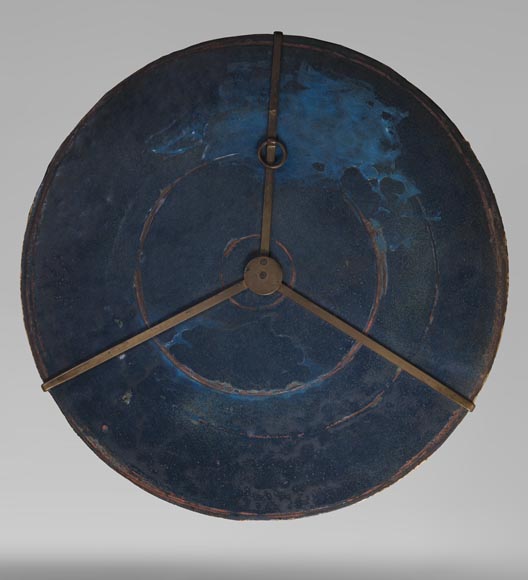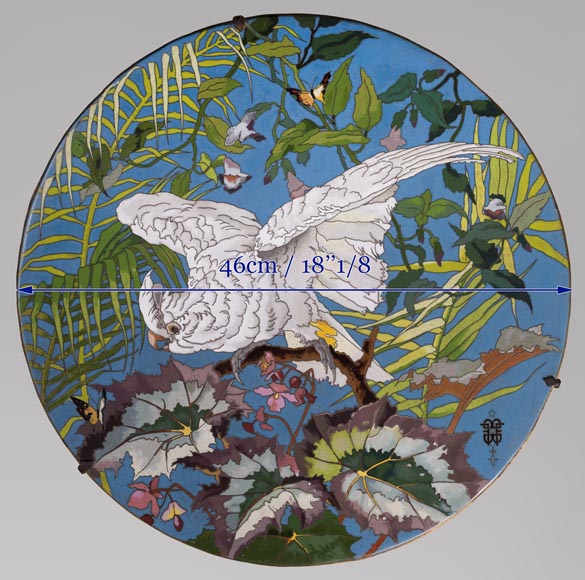Style Japonism, Chinoiserie / Ref.11266
André-Fernand THESMAR (1843-1912) and Ferdinand BARBEDIENNE (1810-1892) - Ornamental japanese style plate
Dimensions
diameter: 18'' ⅛ 46cm
Origin:
France. Between 1872 and 1880.
Monogram in the enamel : two F’s and two B’s interlaced.
Status:
Perfect condition
Plate in gilded bronze and cloisonné enamel decorated with cockatoo on a blue background.
Following the example of the enamel workshops of the factory of Sevres, Ferdinand Barbedienne (1810 - 1892) introduced enamel in its making of art works: “byzantine” champlevé enamels from the end of the 1850s, then neo-Renaissance painted enamels and cloissone enamels with Far-Eastern influence. No other company managed to integrate with such success the use of enamel in an industrial production. After some attempts with independent enamelers, , Barbedienne ensured the exclusive collaboration of remarkable practitioners: Alfred Serre for the painted enamel (before 1872) and Fernand Thesmar for clossoine enamel (after 1872). This plate is a beautiful example of the important production that Barbedienne developed in the years 1870 - 1880, at a time when luxury enamel on precious metals was experience a real craze. The motifs of flowers, birds and insects is again found in a series of similar pieces, combining classic shapes and designs of oriental taste, including a glass kept at the Orsay Museum in Paris and another kept at the Walters Art Gallery, in Baltimore.
Andre-Fernand Thesmar, born March 4 1843 in Chalon-sur-Saone, first devoted himself to oil painting and was known as a painter of flowers. He was educated in drawing in a factory for printed-fabric in Mulhouse where he had been placed at fourteen years old to learn the trade of a draftsman. His teacher was a painter of flowers: he “drew and dissected the plant with fury, requiring an anatomical analysis of shapes and a meticulous copy of nature.” He left this industrial environment to go to Paris in 1860 and engaged in various activities (workshop of industrial drawing and studio decoration for Cambon’s theater.) It was probably for his talent as a painter that Thesmar was noticed in 1872 by Ferdinand Barbedienne. With Barbedienne, later Thesmar succeeded to the management of the production of enamels. The productions of Thesmar and Barbedienne reflected the interest that they had for the decorative techniques and compositions of Japanese enamel. It was as “co-operator of the Barbedienne company” that Thesmar exhibited at the Exhibition of Decorative Arts in 1874, A cock pheasant from China and Floral Bouquets from greenhouse where they admired his talent as a painter of flowers. At the exposition in 1875, Thesmar exhibited two large enamel compositions on leather, one of which displayed a wader with water lilies and bright yellow iris, completely in the style of our plate and showing the style of the return to nature.
In 1891, Thesmar turned to the decoration of porcelain and introduced himself to Charles Lauth who, since 1879, led the Factory de Sèvres. Its at this time that the collaboration with the Barbedienne company ended. Afterwards, he would be especially known for having invented the “plique à jour” technique, which numerous pieces of are kept in public collections.
Informations
Price: on request
Recommended for you :
Dimensions:
Height: 52
Diameter: 48
Dimensions:
Height: 3
Diameter: 32
Dimensions:
Width: 33
Height: 26
Dimensions:
Height: 55
Diameter: 22
Dimensions:
Height: 9
Diameter: 32
Dimensions:
Height: 33
Diameter: 36
Dimensions:
Height: 4
Diameter: 30
Dimensions:
Width: 34
Height: 12
Depth: 34
Dimensions:
Width: 72
Height: 164
Depth: 11
Dimensions:
Diameter: 24
Dimensions:
Height: 26
Diameter: 36
Dimensions:
Diameter: 36



